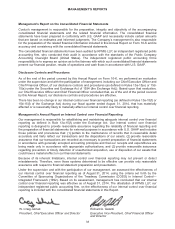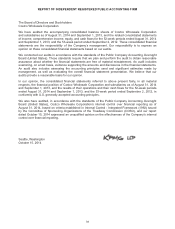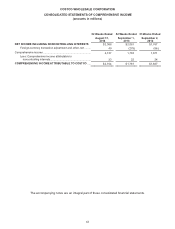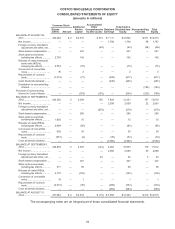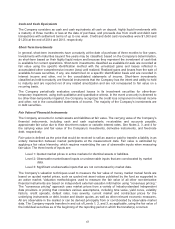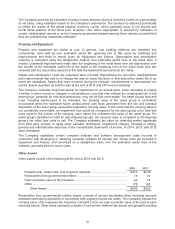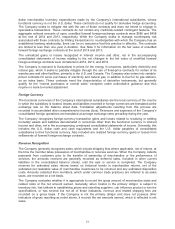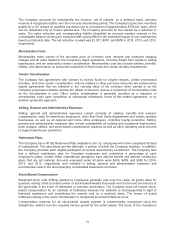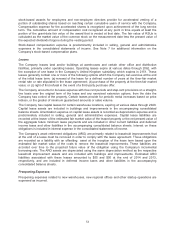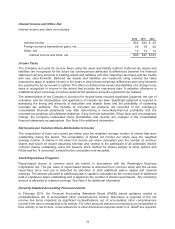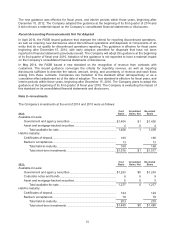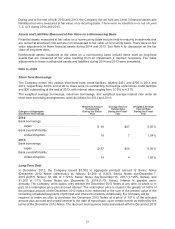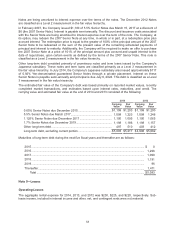Costco 2014 Annual Report Download - page 50
Download and view the complete annual report
Please find page 50 of the 2014 Costco annual report below. You can navigate through the pages in the report by either clicking on the pages listed below, or by using the keyword search tool below to find specific information within the annual report.
The Company’s current financial liabilities have fair values that approximate their carrying values. The
Company’s long-term financial liabilities consist of long-term debt, which is recorded on the balance sheet
at issuance price and adjusted for any applicable unamortized discounts or premiums.
Receivables, Net
Receivables consist of the following at the end of 2014 and 2013:
2014 2013
Vendor receivables .......................................................................................................
.
$
704
$
581
Reinsurance receivables .............................................................................................
.
253
238
Third-party pharmacy receivables ..............................................................................
.
87
102
Other receivables, net ..................................................................................................
.
104
280
Receivables, net ....................................................................................................
.
$
1,148
$ 1,201
Vendor receivables include payments from vendors in the form of volume rebates or other purchase
discounts. Balances are generally presented on a gross basis, separate from any related payable due. In
certain circumstances, these receivables may be settled against the related payable to that vendor.
Reinsurance receivables are held by the Company’s wholly-owned captive insurance subsidiary. The
balance primarily represents amounts ceded through reinsurance arrangements, and are reflected on a
gross basis, separate from the amounts assumed under reinsurance, which are presented on a gross
basis within other current liabilities in the consolidated balance sheets. Third-party pharmacy receivables
generally relate to amounts due from members’ insurance companies for the amount above their co-pay,
which is collected at the point-of-sale. Other receivables primarily consist of amounts due from
governmental entities, of which the majority are tax-related items.
Receivables are recorded net of an allowance for doubtful accounts. Management determines the
allowance for doubtful accounts based on historical experience and application of the specific
identification method. Write-offs of receivables were immaterial for fiscal years 2014, 2013, and 2012.
Merchandise Inventories
Merchandise inventories consist of the following at the end of 2014 and 2013:
2014 2013
United States
(p
rimaril
y
LIFO
)
.....................................................................................
.
$ 5,952
$ 5,560
Foreign (FIFO) ...............................................................................................................
.
2,504
2,334
Merchandise inventories .......................................................................................
.
$ 8,456
$ 7,894
Merchandise inventories are valued at the lower of cost or market, as determined primarily by the retail
inventory method, and are stated using the last-in, first-out (LIFO) method for substantially all U.S.
merchandise inventories. Merchandise inventories for all foreign operations are primarily valued by the
retail inventory method and are stated using the first-in, first-out (FIFO) method. The Company believes
the LIFO method more fairly presents the results of operations by more closely matching current costs
with current revenues. The Company records an adjustment each quarter, if necessary, for the projected
annual effect of inflation or deflation, and these estimates are adjusted to actual results determined at
year-end, after actual inflation rates and inventory levels for the year have been determined.
Due to overall net inflationary trends in 2014 and 2012, charges of $28 and $21 were recorded to
merchandise costs, respectively, to increase the cumulative LIFO valuation on merchandise inventories.
Due to overall net deflationary trends in 2013, a benefit of $27 was recorded to merchandise costs. At the
end of 2014 and 2013, the cumulative impact of the LIFO valuation on merchandise inventories was $109
and $81, respectively.
48


